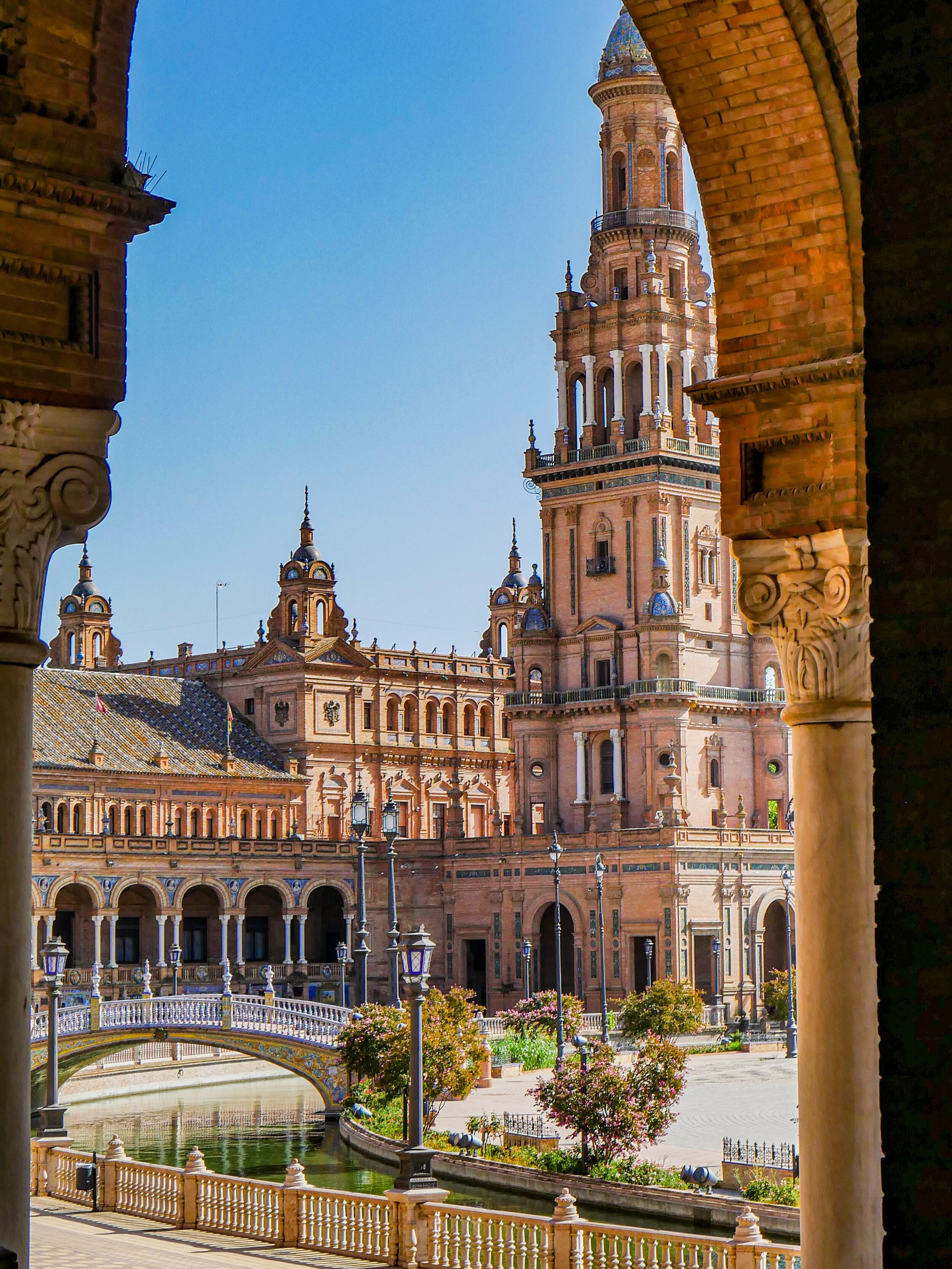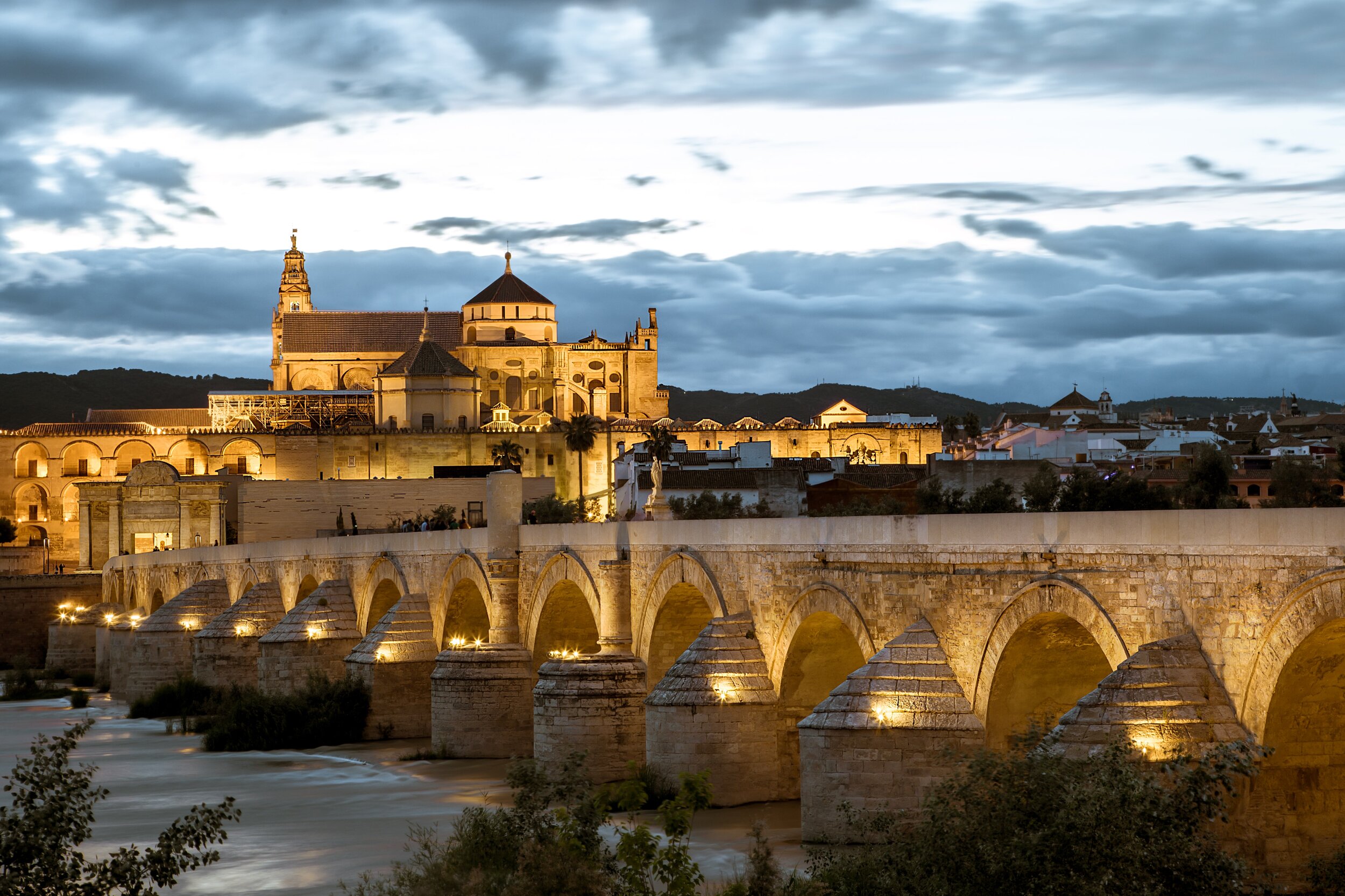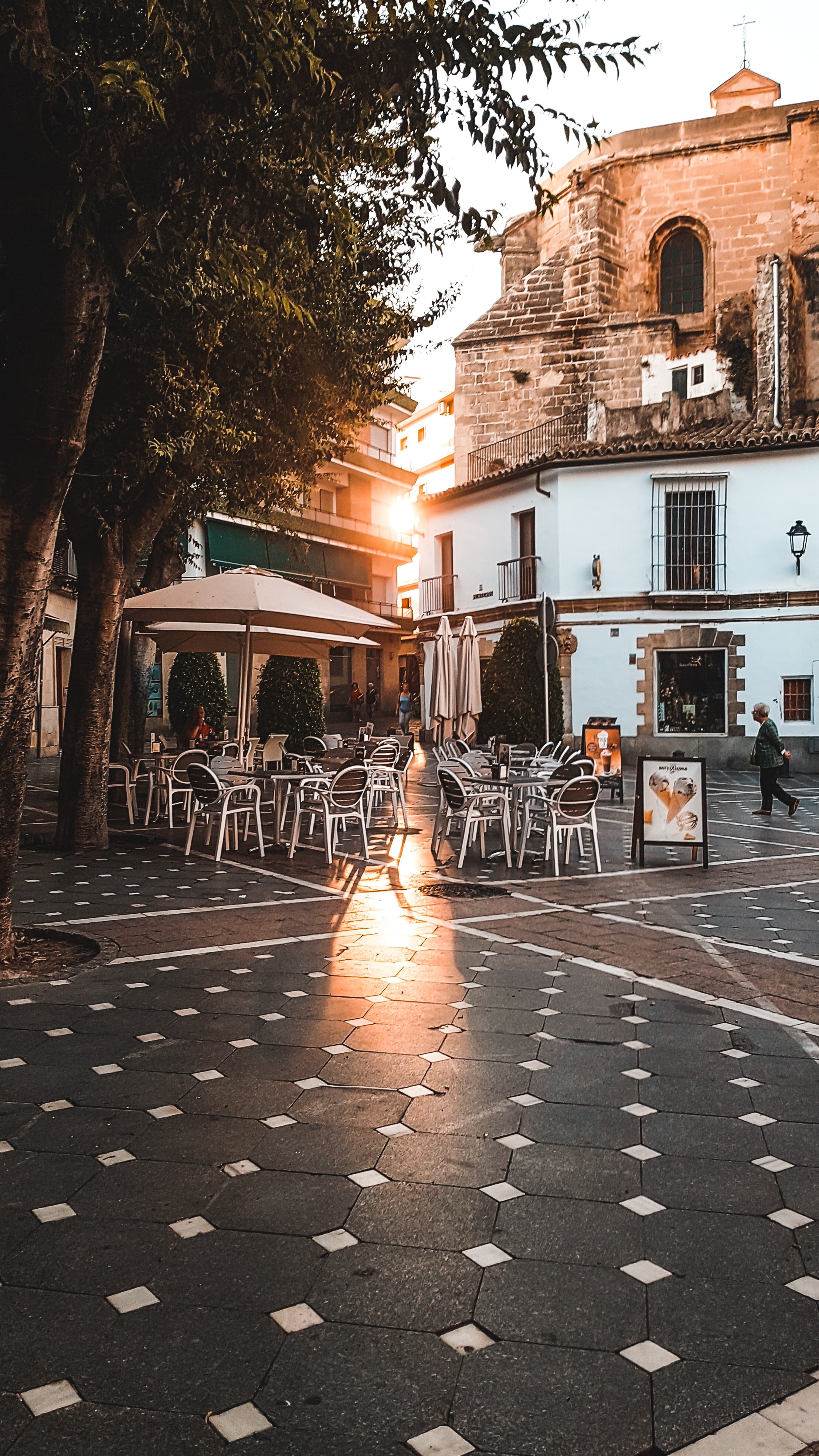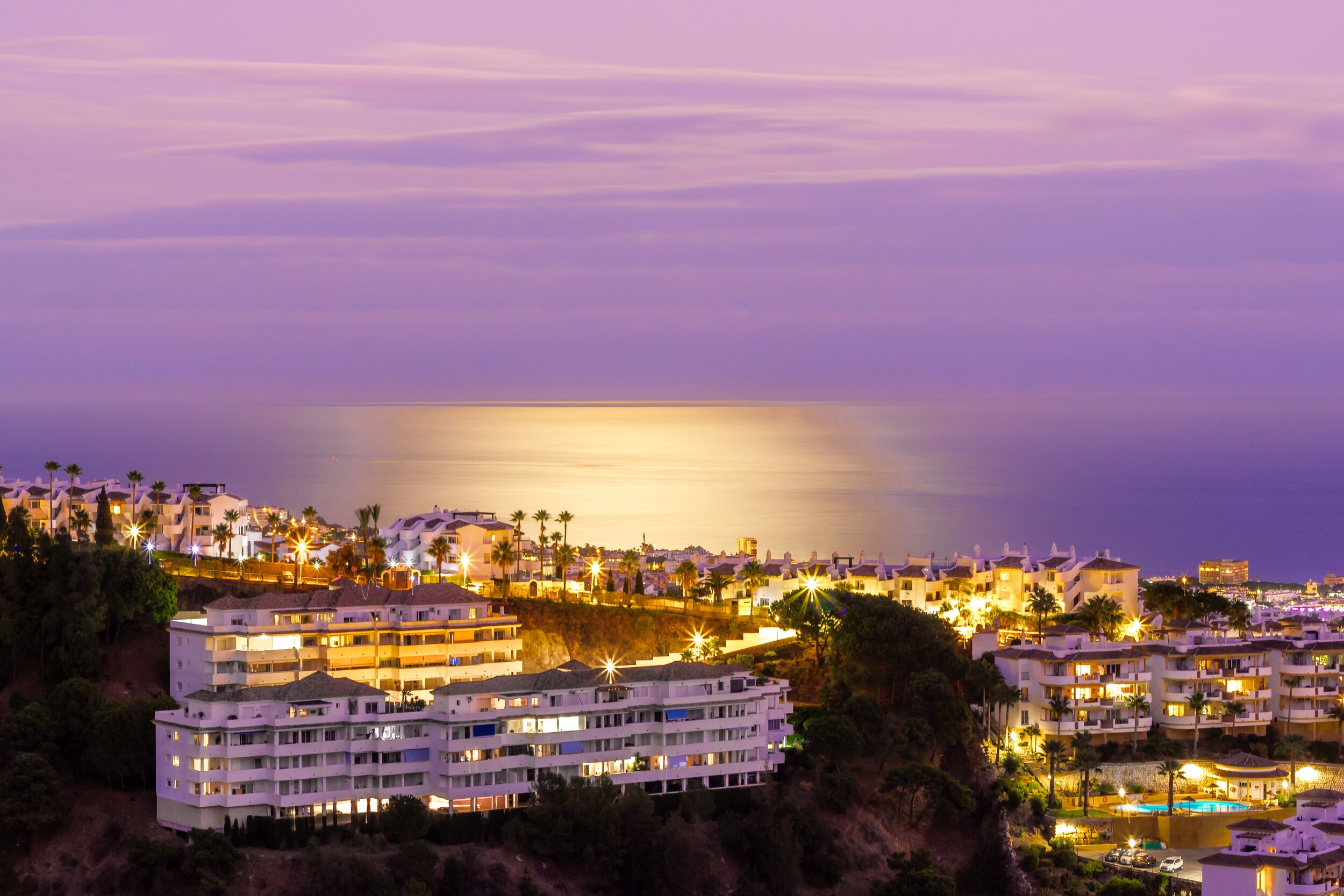A Dazzling Sensory Adventure Awaits You in Andalusia
When you first arrive in the Andalusian region of southern Spain, you may feel like you've stepped into a fairytale, or a beautiful daydream, or maybe it seems you've time-traveled back to an ancient land. Any of these descriptions are appropriate for this lush area where exotic foliage like wild olive, juniper, jacaranda, and cork oak trees dot the landscape among an abundance of castles, cathedrals, ancient ruins, and many more significant historical and religious sites.
Plaza de España, Seville, Spain
Traveling through Andalusia, you simply can't help but notice the sensory delights that greet you everywhere you go. You may catch the scent of orange blossoms. Hear the soothing trickle of water in a courtyard fountain. Feel the cool touch of ancient rock walls surrounding many of the ancient cities. Observe breathtaking panoramic views from high above the ground. Indulge in a glass of sherry, or a taste of salmorejo (the Andalusian gazpacho), fresh figs, or maybe fresh-caught fish right from the sea.
Andalusia is rich in history and culture, with a fascinating mix of Christian, Moorish and Jewish influences, signs of which are apparent everywhere you go in this part of Spain. In fact, Andalusia's name is derived from Arabic – and in ancient times was known as al-Andalus – which means "land of the west."
During your stay, you will find many exciting adventures to explore, including a large variety of UNESCO World Heritage Sites that are a must-see for travelers looking to experience the beauty, elegance, and eclectic mix of cultural influences that make this region so unique.
Seville and Granada often get much of the attention in this region of Spain, and for very good reason. Let me give you just a small taste of these cities and more in this enchanting, exciting part of the country.
Granada
The Alhambra from our visit to Granada, Spain in October 2015. Photo Credit: Kosh Patel
One of the most iconic destinations, not just in Granada but throughout all of Spain, is, without a doubt, the Alhambra. This stunningly beautiful, intricate work of art and architecture is now a sprawling, gargantuan complex that will make an impression. Situated among the Sierra Nevada peaks, this 13th-century fortress was the palace of Nasrid kings (the Moorish rulers of Andalusia) until 1492, the time of the Reconquista (the Christian conquest). When Queen Isabella I of Castile and King Ferdinand II of Aragon came to power, they turned the mosque into a church but kept the Alhambra otherwise primarily intact as a powerful symbol of Catholic supremacy. There are many sites to see within the Alhambra, and a gem is the Generalife, a summer palace that dates back to the 14th century. Its lush gardens and tranquil setting boast a series of patios, fountains, reflecting pools, and fragrant trees and flowers to awaken your senses with their heavenly scents and gorgeous, vibrant colors.
The Catedral de Granada (Granada Cathedral) is the second largest cathedral in Spain. Like many religious sites throughout Andalusia, it was created from a mix of cultural, artistic, and architectural influences. Built on the site of Granada's city mosque, the cathedral was constructed in 1523, followed by nearly two centuries of alterations, with many architects involved along the way. Its original Gothic footprint was replaced with a Renaissance style ultimately resulting in an interesting blend of styles.
Capilla Real, the Royal Chapel of Granada, is a lavish 16th-century shrine commissioned by Queen Isabella and King Ferdinand. It also houses a small museum where precious royal objects and works of art are on display.
Córdoba, Spain
Before you leave Granada, be sure to visit the Albaicín (the Old Muslim Quarter, another carefully preserved UNESCO site) for its Old World charm and of course to sample authentic falafel and kebabs to enjoy with your mint tea and honey-kissed pastries.
Córdoba
Córdoba, which at one time was one of Europe's largest cultural centers, was also considered the capital of Islamic Spain. Here in Córdoba, you will experience another exquisite example of Moorish architecture, the Mezquita (the Mosque of Córdoba), but today it functions as a church and is formally known as the Cathedral of Our Lady of the Assumption. Its staggering beauty will leave you speechless. You will be enchanted by the Patio de los Naranjos (the Courtyard of Oranges) with its perfectly manicured orange, palm and cypress trees that mark the entrance to the Mezquita.
Just outside Córdoba is Medina Azahara, one of Spain's most important archeological sites, where you can explore the ancient ruins and imagine what this site must have looked like at its height. This former palace and royal city were built by a 10th-century caliph.
Córdoba is also home to Arab and Jewish quarters with their labyrinthine narrow streets lined with whitewashed houses adorned with flowering plants on their patios and balconies. Each year, Córdoba residents compete in a contest for the most attractive courtyard. Incidentally, courtyards are a classic example of ancient Moorish architecture that is still "in vogue" today.
Jerez de la Frontera, Spain
The Sherry Triangle
In Jerez de la Frontera, you can engage in two long-held traditions that are the pride of Andalusia. The first is sherry. Jerez (as it is known), along with the cities of El Puerto de Santa María and Sanlúcar de Barrameda, are known as "The Sherry Triangle," named for the region where vintners have been producing sherry for more than 3,000 years. Many travelers gravitate toward Jerez for sherry tastings, but beyond Jerez, you can also explore some of the other cities producing sherry in this region.
Also in Jerez de la Frontera, another cultural icon is found: The Dancing Horses of Andalusia. These regal horses are native to the Iberian Peninsula, dating back to the 15th-century, where they were often kept by nobility. The performances of the dancing horses display a certain level of pageantry, drama, elegance, romance and athleticism that will leave you fascinated.
Cádiz
Cádiz is the oldest continuously inhabited city in Western Europe. The different people who have settled here over time, including the Phoenicians, who founded it, have left their cultural mark on the city. Surrounded mostly by water, this animated port city with its old narrow streets has been known for its sand, its wildly festive and elaborate pre-Lenten Carnival celebration, and its fresh seafood. In recent years, Cádiz has garnered some attention for its culinary scene, bringing together the region's offerings in both traditional and innovative ways.
Ronda, Spain, one of the most well known white towns on the Ruta de los Pueblos Blancos
Pueblos Blancos, The White Villages
You can also explore the countryside with its Pueblos Blancos, rolling hills, and lush groves in Andalusia. Find whitewashed towns, each in their own picturesque settings, from sprawling along a hillside to sitting atop a rocky mount overlooking a gorge. Of course, each has its distinct personality as well. Find centuries-old bathhouses and churches as you stroll along cobblestone streets. Along the way, taste honey pancakes and artisanal cheese or find a special handmade craft. The area is also known for its flora and fauna and is renowned for its bird watching.
Costa del Sol
Marbella, Spain along the Costa del Sol
For a bit of relaxation along the coast while in Andalusia, visit the Costa del Sol, which encompasses several different beaches, each with its flair. Some say the upscale, well-heeled resort town of Marbella is the crown jewel of the so-called "Spanish Riviera." Here you can take a leisurely stroll along the Paseo Marítimo, with the water on one side and lovely gardens on the other. Watch the yachts go by and then wind your way through the narrow cobblestone streets of Old Town Marbella, then enjoy a late dinner among the many fine restaurants you will find here.
For a different Costa del Sol adventure, Málaga has more of a hip, artsy feel, and the arrival of the Museo Picasso in 2003, along with a major cruise ship terminal in 2011, have brought many travelers to this up and coming coastal city in past years. Málaga now boasts several art museums and galleries, and consequently, a number of lively bars and restaurants have popped up, offering many opportunities to enjoy some fresh seafood or a tinto de verano (summer sangria) on a warm evening.
Seville
Seville, of course, is one of the best-known gems of this region. While it may be the most cosmopolitan city in Andalusia, it still oozes with the richness of its heritage. The ornate décor of Spanish Baroque is prevalent and is influenced by Moorish details and Catholic influences. You will also sense the North African influence here, and in the markets and restaurants, you are likely to find an abundance of saffron, dates, almonds, and citrus fruits.
Plaza de España, Seville, Spain
While in Seville, you must take in a flamenco performance. Sevillanas (the women of Seville) love their flamenco, and even non-performers have at least one and probably several flamenco dresses in their closet. Flamenco is a form of song and dance native to Andalusia. And while flamenco is Spanish at its core, it incorporates other cultures, including Roma ("Gitanos") and Jewish influences. At flamenco performances, you'll hear people shouting the word "duende." It's difficult to translate literally but essentially embodies the spirit, passion, and mystique of the dance.
Plaza de España, Seville, Spain
For amazing views of Seville, it's worth trekking to the top of the spire of La Giralda (the bell tower of the Seville Cathedral). This is yet another example of a mosque turned cathedral. During the Almohad dynasty, the structure was originally built with a minaret on top, which was replaced with a cathedral spire when Muslims were removed from the region.
Also, in Seville, you will discover the Alcázar of Seville, which was mainly constructed in the Moorish in style but also includes Gothic, Renaissance, and Romanesque elements. Enjoy the splendor of Queen Isabella's garden while you are there. This is also a part-time residence for the Spanish royal family.
There is so much more to discover in Seville, as well as in all of the Andalusian region.
Are you ready to immerse yourself in the sights, sounds, and tastes of magical Andalusia? Contact us to plan your future journey here.









